Expectation-Performance Gap in Audit Inspection Process
VerifiedAdded on 2023/06/18
|9
|2535
|242
Report
AI Summary
This report provides a detailed analysis of the audit expectation-performance gap within the context of the audit inspection process, focusing on the planning, performance, and reporting phases. It explores how each phase links to the components of the audit expectation gap model, such as d...

AUDITING
Paraphrase This Document
Need a fresh take? Get an instant paraphrase of this document with our AI Paraphraser
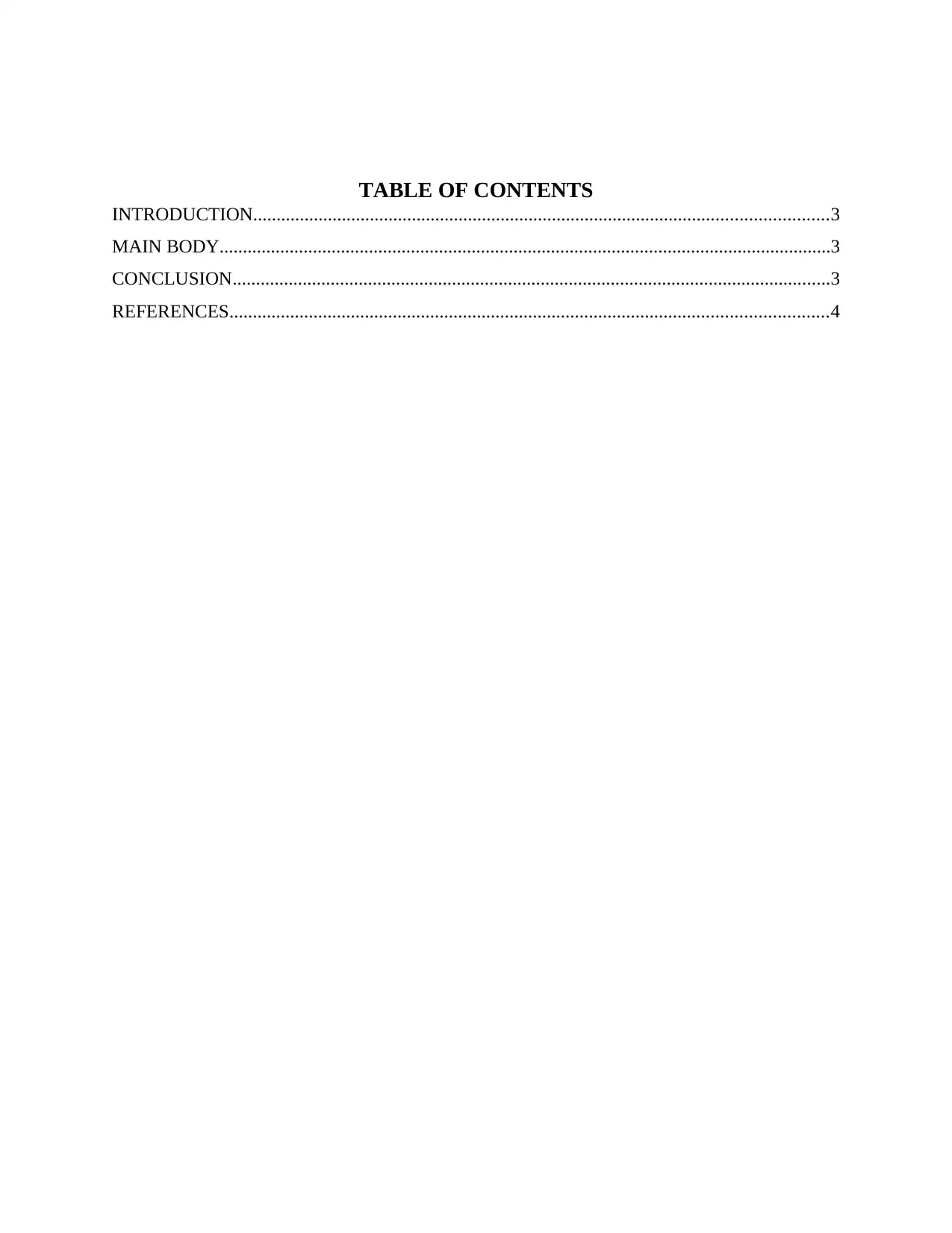
TABLE OF CONTENTS
INTRODUCTION...........................................................................................................................3
MAIN BODY...................................................................................................................................3
CONCLUSION................................................................................................................................3
REFERENCES................................................................................................................................4
INTRODUCTION...........................................................................................................................3
MAIN BODY...................................................................................................................................3
CONCLUSION................................................................................................................................3
REFERENCES................................................................................................................................4
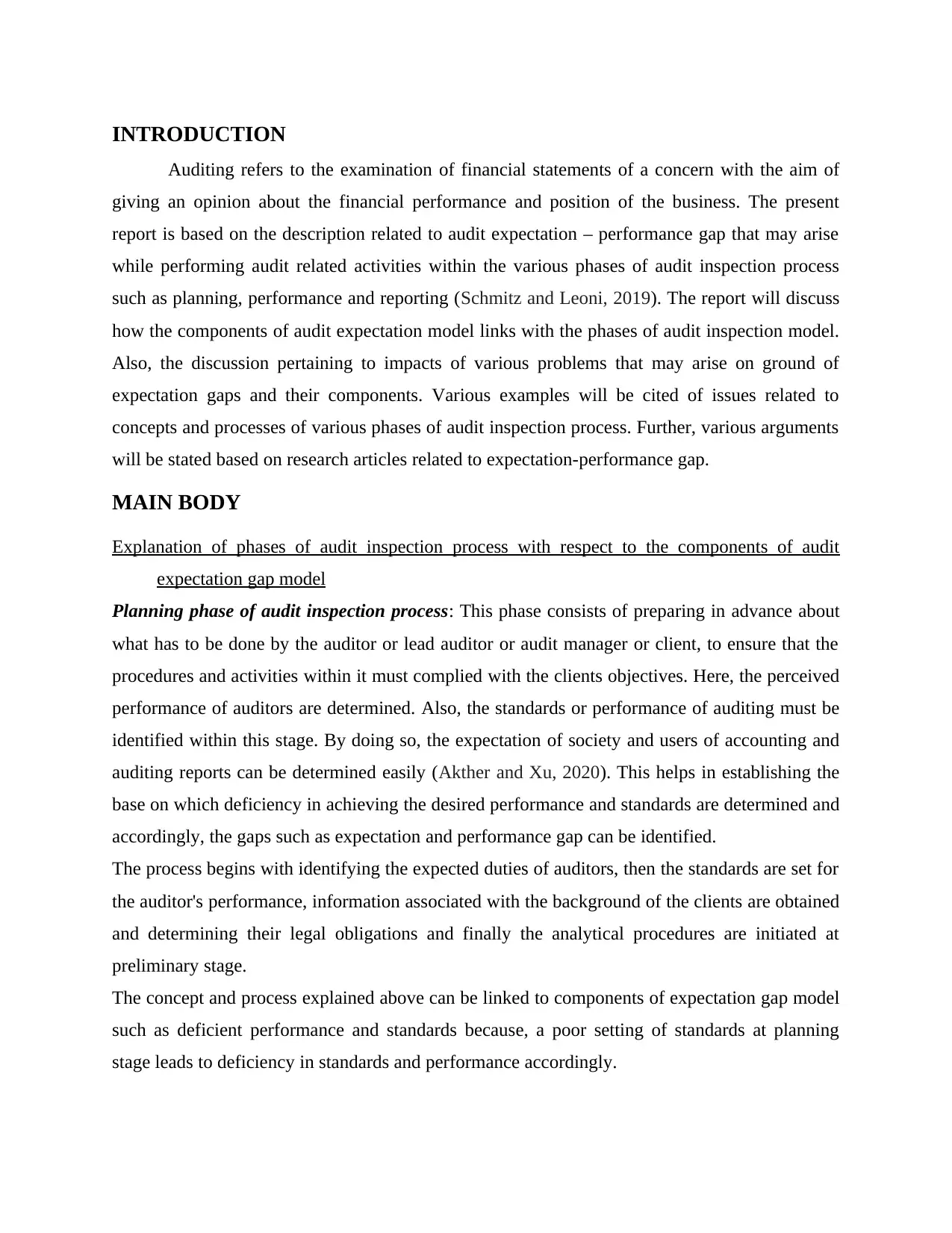
INTRODUCTION
Auditing refers to the examination of financial statements of a concern with the aim of
giving an opinion about the financial performance and position of the business. The present
report is based on the description related to audit expectation – performance gap that may arise
while performing audit related activities within the various phases of audit inspection process
such as planning, performance and reporting (Schmitz and Leoni, 2019). The report will discuss
how the components of audit expectation model links with the phases of audit inspection model.
Also, the discussion pertaining to impacts of various problems that may arise on ground of
expectation gaps and their components. Various examples will be cited of issues related to
concepts and processes of various phases of audit inspection process. Further, various arguments
will be stated based on research articles related to expectation-performance gap.
MAIN BODY
Explanation of phases of audit inspection process with respect to the components of audit
expectation gap model
Planning phase of audit inspection process: This phase consists of preparing in advance about
what has to be done by the auditor or lead auditor or audit manager or client, to ensure that the
procedures and activities within it must complied with the clients objectives. Here, the perceived
performance of auditors are determined. Also, the standards or performance of auditing must be
identified within this stage. By doing so, the expectation of society and users of accounting and
auditing reports can be determined easily (Akther and Xu, 2020). This helps in establishing the
base on which deficiency in achieving the desired performance and standards are determined and
accordingly, the gaps such as expectation and performance gap can be identified.
The process begins with identifying the expected duties of auditors, then the standards are set for
the auditor's performance, information associated with the background of the clients are obtained
and determining their legal obligations and finally the analytical procedures are initiated at
preliminary stage.
The concept and process explained above can be linked to components of expectation gap model
such as deficient performance and standards because, a poor setting of standards at planning
stage leads to deficiency in standards and performance accordingly.
Auditing refers to the examination of financial statements of a concern with the aim of
giving an opinion about the financial performance and position of the business. The present
report is based on the description related to audit expectation – performance gap that may arise
while performing audit related activities within the various phases of audit inspection process
such as planning, performance and reporting (Schmitz and Leoni, 2019). The report will discuss
how the components of audit expectation model links with the phases of audit inspection model.
Also, the discussion pertaining to impacts of various problems that may arise on ground of
expectation gaps and their components. Various examples will be cited of issues related to
concepts and processes of various phases of audit inspection process. Further, various arguments
will be stated based on research articles related to expectation-performance gap.
MAIN BODY
Explanation of phases of audit inspection process with respect to the components of audit
expectation gap model
Planning phase of audit inspection process: This phase consists of preparing in advance about
what has to be done by the auditor or lead auditor or audit manager or client, to ensure that the
procedures and activities within it must complied with the clients objectives. Here, the perceived
performance of auditors are determined. Also, the standards or performance of auditing must be
identified within this stage. By doing so, the expectation of society and users of accounting and
auditing reports can be determined easily (Akther and Xu, 2020). This helps in establishing the
base on which deficiency in achieving the desired performance and standards are determined and
accordingly, the gaps such as expectation and performance gap can be identified.
The process begins with identifying the expected duties of auditors, then the standards are set for
the auditor's performance, information associated with the background of the clients are obtained
and determining their legal obligations and finally the analytical procedures are initiated at
preliminary stage.
The concept and process explained above can be linked to components of expectation gap model
such as deficient performance and standards because, a poor setting of standards at planning
stage leads to deficiency in standards and performance accordingly.
⊘ This is a preview!⊘
Do you want full access?
Subscribe today to unlock all pages.

Trusted by 1+ million students worldwide
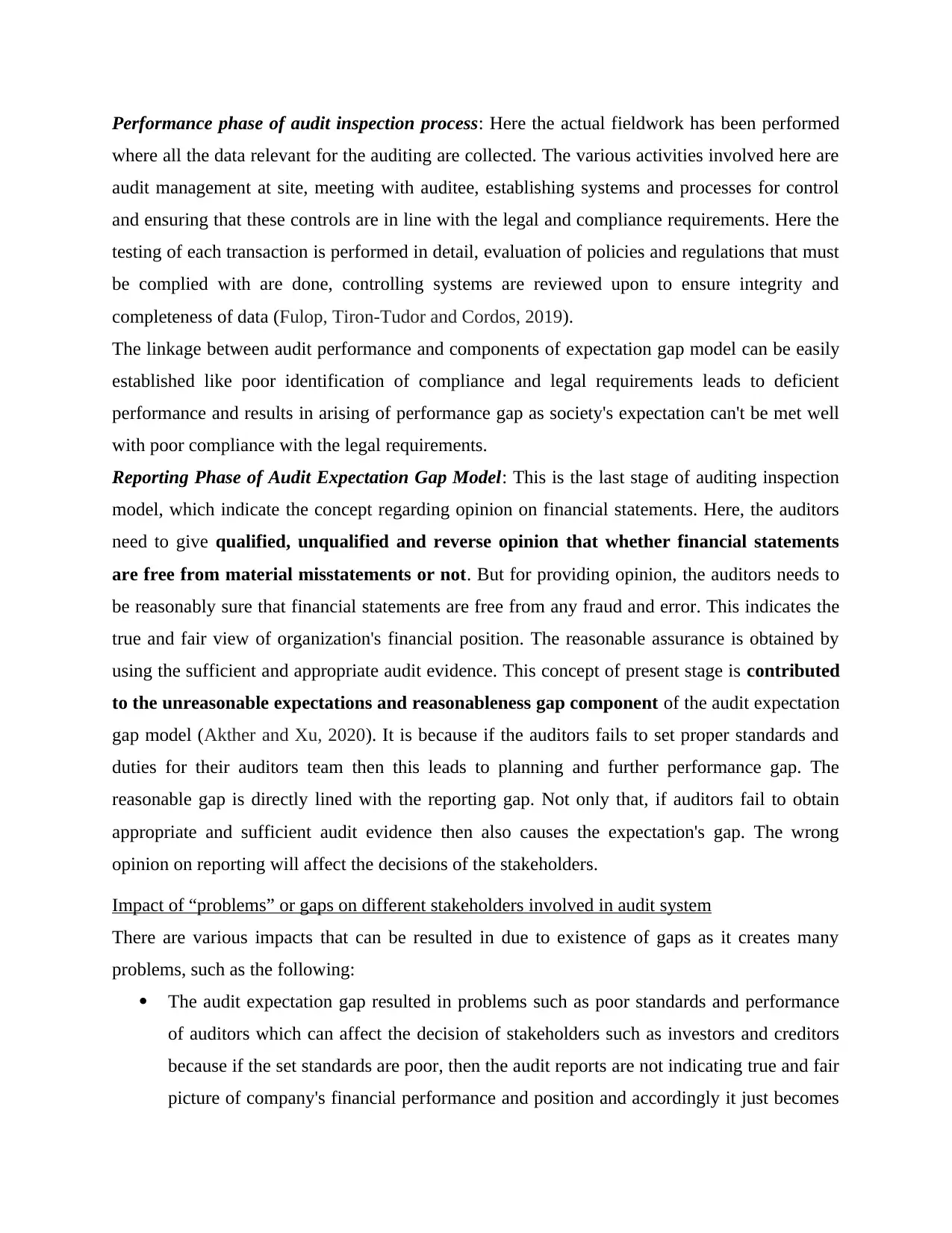
Performance phase of audit inspection process: Here the actual fieldwork has been performed
where all the data relevant for the auditing are collected. The various activities involved here are
audit management at site, meeting with auditee, establishing systems and processes for control
and ensuring that these controls are in line with the legal and compliance requirements. Here the
testing of each transaction is performed in detail, evaluation of policies and regulations that must
be complied with are done, controlling systems are reviewed upon to ensure integrity and
completeness of data (Fulop, Tiron-Tudor and Cordos, 2019).
The linkage between audit performance and components of expectation gap model can be easily
established like poor identification of compliance and legal requirements leads to deficient
performance and results in arising of performance gap as society's expectation can't be met well
with poor compliance with the legal requirements.
Reporting Phase of Audit Expectation Gap Model: This is the last stage of auditing inspection
model, which indicate the concept regarding opinion on financial statements. Here, the auditors
need to give qualified, unqualified and reverse opinion that whether financial statements
are free from material misstatements or not. But for providing opinion, the auditors needs to
be reasonably sure that financial statements are free from any fraud and error. This indicates the
true and fair view of organization's financial position. The reasonable assurance is obtained by
using the sufficient and appropriate audit evidence. This concept of present stage is contributed
to the unreasonable expectations and reasonableness gap component of the audit expectation
gap model (Akther and Xu, 2020). It is because if the auditors fails to set proper standards and
duties for their auditors team then this leads to planning and further performance gap. The
reasonable gap is directly lined with the reporting gap. Not only that, if auditors fail to obtain
appropriate and sufficient audit evidence then also causes the expectation's gap. The wrong
opinion on reporting will affect the decisions of the stakeholders.
Impact of “problems” or gaps on different stakeholders involved in audit system
There are various impacts that can be resulted in due to existence of gaps as it creates many
problems, such as the following:
The audit expectation gap resulted in problems such as poor standards and performance
of auditors which can affect the decision of stakeholders such as investors and creditors
because if the set standards are poor, then the audit reports are not indicating true and fair
picture of company's financial performance and position and accordingly it just becomes
where all the data relevant for the auditing are collected. The various activities involved here are
audit management at site, meeting with auditee, establishing systems and processes for control
and ensuring that these controls are in line with the legal and compliance requirements. Here the
testing of each transaction is performed in detail, evaluation of policies and regulations that must
be complied with are done, controlling systems are reviewed upon to ensure integrity and
completeness of data (Fulop, Tiron-Tudor and Cordos, 2019).
The linkage between audit performance and components of expectation gap model can be easily
established like poor identification of compliance and legal requirements leads to deficient
performance and results in arising of performance gap as society's expectation can't be met well
with poor compliance with the legal requirements.
Reporting Phase of Audit Expectation Gap Model: This is the last stage of auditing inspection
model, which indicate the concept regarding opinion on financial statements. Here, the auditors
need to give qualified, unqualified and reverse opinion that whether financial statements
are free from material misstatements or not. But for providing opinion, the auditors needs to
be reasonably sure that financial statements are free from any fraud and error. This indicates the
true and fair view of organization's financial position. The reasonable assurance is obtained by
using the sufficient and appropriate audit evidence. This concept of present stage is contributed
to the unreasonable expectations and reasonableness gap component of the audit expectation
gap model (Akther and Xu, 2020). It is because if the auditors fails to set proper standards and
duties for their auditors team then this leads to planning and further performance gap. The
reasonable gap is directly lined with the reporting gap. Not only that, if auditors fail to obtain
appropriate and sufficient audit evidence then also causes the expectation's gap. The wrong
opinion on reporting will affect the decisions of the stakeholders.
Impact of “problems” or gaps on different stakeholders involved in audit system
There are various impacts that can be resulted in due to existence of gaps as it creates many
problems, such as the following:
The audit expectation gap resulted in problems such as poor standards and performance
of auditors which can affect the decision of stakeholders such as investors and creditors
because if the set standards are poor, then the audit reports are not indicating true and fair
picture of company's financial performance and position and accordingly it just becomes
Paraphrase This Document
Need a fresh take? Get an instant paraphrase of this document with our AI Paraphraser

a tool of publicizing the company and divert the decisions of stakeholders (Schmitz and
Leoni, 2019).
If the duties determined of the auditors are not up to the expectations of the society, then
there will be a performance gap in auditing and the impact of this could be deficiency in
performance where stakeholders decisions are if based on the audit report that has been
made on the basis of deficient auditing, this leads to uninformed decision-making by the
stakeholders.
When there exists deficient performance, then whatever evidence exists for each and
every transaction of the business are not gathered appropriately and sufficiently.
Accordingly, an inclusion of material misstatement may not be identified as required by
law.
Unreasonable expectations may arise on the ground of misunderstanding and
unawareness of the users regarding auditor's performance and responsibilities. This leads
to the expectation performance gap and stakeholders are not able to exploit opportunities
of investing in a profitable concern.
The example of issues raised in each concept or processes Planning and allocation of duties and standards of auditors: The planning stage cover
the concept in which duties of each auditor are set and also the standards are pre-
determined which need to be followed by all auditors. For example, the auditors do not
comply with audit standards such as ISA (UK) 500 “Audit Evidence” and ISA (UK) 230
“Audit Documentation in proper manner. This non-compliance of set standards also
result into non-fulfilment of auditors duties (Turetken, Jethefer and Ozkan, 2019). The
impact of which the auditors give clear opinion on financial statement rather than
qualified and adverse opinion. This is an example of issue arises in the planning stage of
the audit inspection processes. Audit Test: This is an issue arises in the performance stage of the audit inspection which
affects the performance of the company as well as decision of the stakeholders such as
investors etc. For example, the non-compliance of test of detailed balance and analytical
procedure test is an issue arises in the present case study. This is an issue because the
company do not record contingent transaction such as suit on company where high
probability is arises for loss. The non-recording and disclosure of this transaction is fault
Leoni, 2019).
If the duties determined of the auditors are not up to the expectations of the society, then
there will be a performance gap in auditing and the impact of this could be deficiency in
performance where stakeholders decisions are if based on the audit report that has been
made on the basis of deficient auditing, this leads to uninformed decision-making by the
stakeholders.
When there exists deficient performance, then whatever evidence exists for each and
every transaction of the business are not gathered appropriately and sufficiently.
Accordingly, an inclusion of material misstatement may not be identified as required by
law.
Unreasonable expectations may arise on the ground of misunderstanding and
unawareness of the users regarding auditor's performance and responsibilities. This leads
to the expectation performance gap and stakeholders are not able to exploit opportunities
of investing in a profitable concern.
The example of issues raised in each concept or processes Planning and allocation of duties and standards of auditors: The planning stage cover
the concept in which duties of each auditor are set and also the standards are pre-
determined which need to be followed by all auditors. For example, the auditors do not
comply with audit standards such as ISA (UK) 500 “Audit Evidence” and ISA (UK) 230
“Audit Documentation in proper manner. This non-compliance of set standards also
result into non-fulfilment of auditors duties (Turetken, Jethefer and Ozkan, 2019). The
impact of which the auditors give clear opinion on financial statement rather than
qualified and adverse opinion. This is an example of issue arises in the planning stage of
the audit inspection processes. Audit Test: This is an issue arises in the performance stage of the audit inspection which
affects the performance of the company as well as decision of the stakeholders such as
investors etc. For example, the non-compliance of test of detailed balance and analytical
procedure test is an issue arises in the present case study. This is an issue because the
company do not record contingent transaction such as suit on company where high
probability is arises for loss. The non-recording and disclosure of this transaction is fault
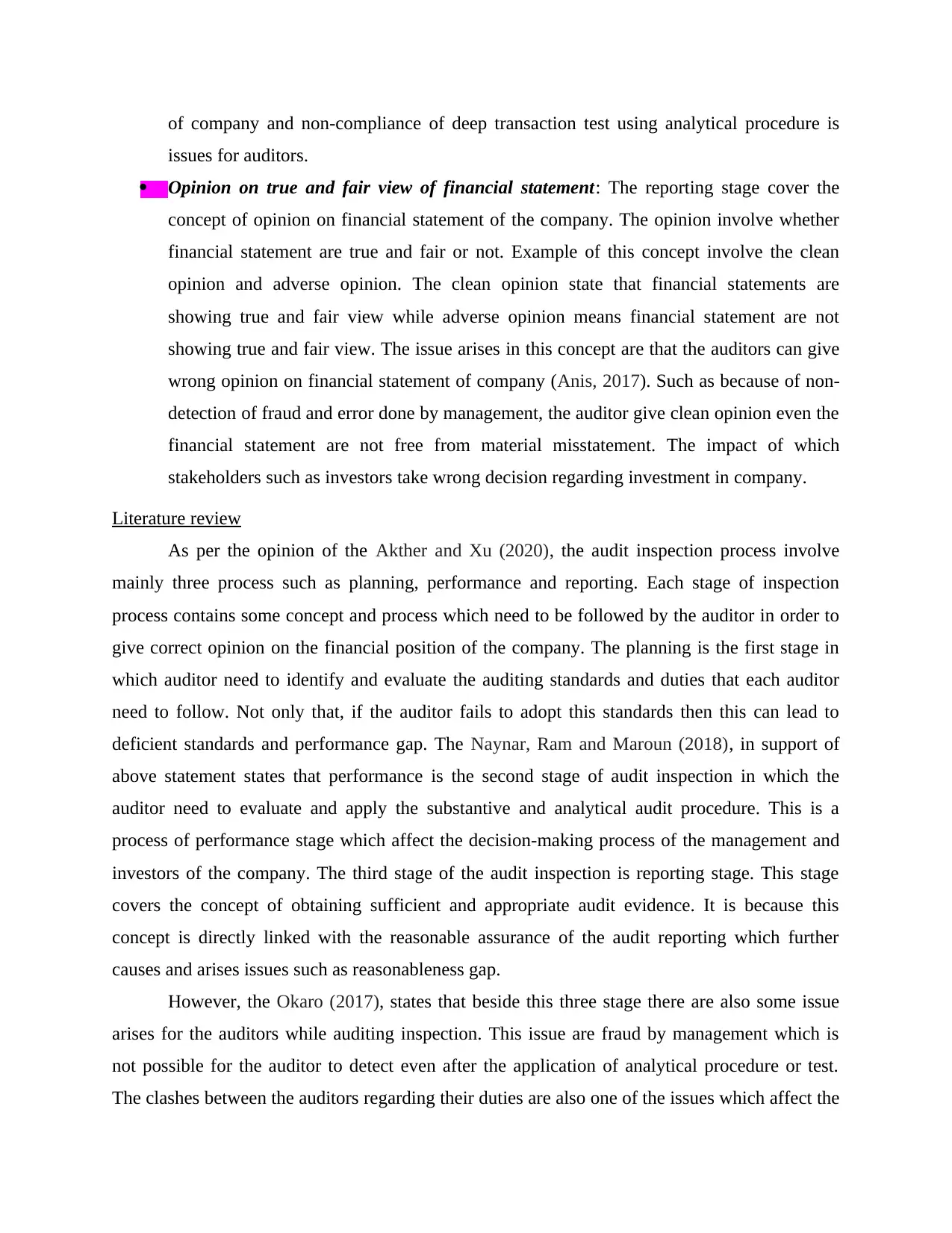
of company and non-compliance of deep transaction test using analytical procedure is
issues for auditors.
Opinion on true and fair view of financial statement: The reporting stage cover the
concept of opinion on financial statement of the company. The opinion involve whether
financial statement are true and fair or not. Example of this concept involve the clean
opinion and adverse opinion. The clean opinion state that financial statements are
showing true and fair view while adverse opinion means financial statement are not
showing true and fair view. The issue arises in this concept are that the auditors can give
wrong opinion on financial statement of company (Anis, 2017). Such as because of non-
detection of fraud and error done by management, the auditor give clean opinion even the
financial statement are not free from material misstatement. The impact of which
stakeholders such as investors take wrong decision regarding investment in company.
Literature review
As per the opinion of the Akther and Xu (2020), the audit inspection process involve
mainly three process such as planning, performance and reporting. Each stage of inspection
process contains some concept and process which need to be followed by the auditor in order to
give correct opinion on the financial position of the company. The planning is the first stage in
which auditor need to identify and evaluate the auditing standards and duties that each auditor
need to follow. Not only that, if the auditor fails to adopt this standards then this can lead to
deficient standards and performance gap. The Naynar, Ram and Maroun (2018), in support of
above statement states that performance is the second stage of audit inspection in which the
auditor need to evaluate and apply the substantive and analytical audit procedure. This is a
process of performance stage which affect the decision-making process of the management and
investors of the company. The third stage of the audit inspection is reporting stage. This stage
covers the concept of obtaining sufficient and appropriate audit evidence. It is because this
concept is directly linked with the reasonable assurance of the audit reporting which further
causes and arises issues such as reasonableness gap.
However, the Okaro (2017), states that beside this three stage there are also some issue
arises for the auditors while auditing inspection. This issue are fraud by management which is
not possible for the auditor to detect even after the application of analytical procedure or test.
The clashes between the auditors regarding their duties are also one of the issues which affect the
issues for auditors.
Opinion on true and fair view of financial statement: The reporting stage cover the
concept of opinion on financial statement of the company. The opinion involve whether
financial statement are true and fair or not. Example of this concept involve the clean
opinion and adverse opinion. The clean opinion state that financial statements are
showing true and fair view while adverse opinion means financial statement are not
showing true and fair view. The issue arises in this concept are that the auditors can give
wrong opinion on financial statement of company (Anis, 2017). Such as because of non-
detection of fraud and error done by management, the auditor give clean opinion even the
financial statement are not free from material misstatement. The impact of which
stakeholders such as investors take wrong decision regarding investment in company.
Literature review
As per the opinion of the Akther and Xu (2020), the audit inspection process involve
mainly three process such as planning, performance and reporting. Each stage of inspection
process contains some concept and process which need to be followed by the auditor in order to
give correct opinion on the financial position of the company. The planning is the first stage in
which auditor need to identify and evaluate the auditing standards and duties that each auditor
need to follow. Not only that, if the auditor fails to adopt this standards then this can lead to
deficient standards and performance gap. The Naynar, Ram and Maroun (2018), in support of
above statement states that performance is the second stage of audit inspection in which the
auditor need to evaluate and apply the substantive and analytical audit procedure. This is a
process of performance stage which affect the decision-making process of the management and
investors of the company. The third stage of the audit inspection is reporting stage. This stage
covers the concept of obtaining sufficient and appropriate audit evidence. It is because this
concept is directly linked with the reasonable assurance of the audit reporting which further
causes and arises issues such as reasonableness gap.
However, the Okaro (2017), states that beside this three stage there are also some issue
arises for the auditors while auditing inspection. This issue are fraud by management which is
not possible for the auditor to detect even after the application of analytical procedure or test.
The clashes between the auditors regarding their duties are also one of the issues which affect the
⊘ This is a preview!⊘
Do you want full access?
Subscribe today to unlock all pages.

Trusted by 1+ million students worldwide
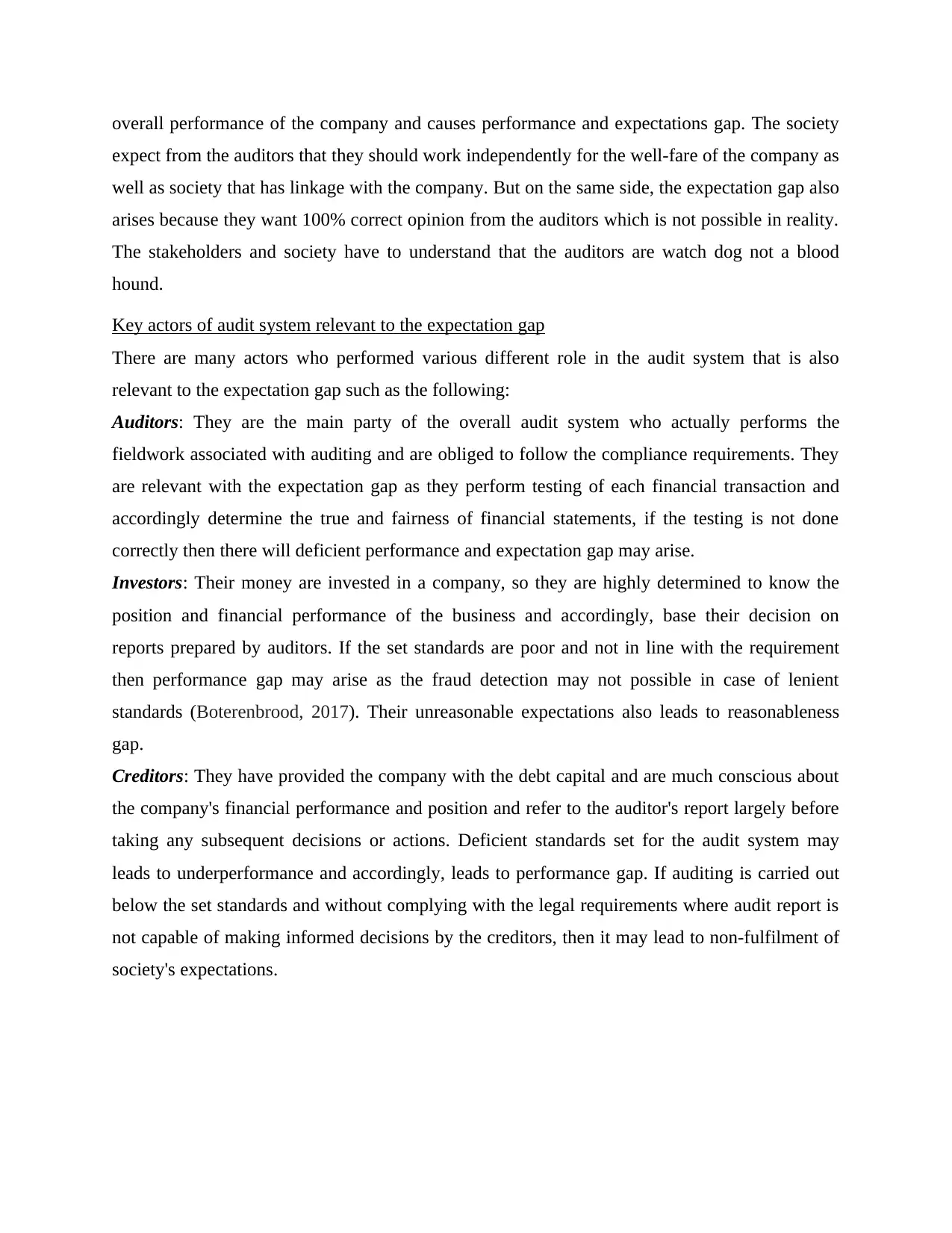
overall performance of the company and causes performance and expectations gap. The society
expect from the auditors that they should work independently for the well-fare of the company as
well as society that has linkage with the company. But on the same side, the expectation gap also
arises because they want 100% correct opinion from the auditors which is not possible in reality.
The stakeholders and society have to understand that the auditors are watch dog not a blood
hound.
Key actors of audit system relevant to the expectation gap
There are many actors who performed various different role in the audit system that is also
relevant to the expectation gap such as the following:
Auditors: They are the main party of the overall audit system who actually performs the
fieldwork associated with auditing and are obliged to follow the compliance requirements. They
are relevant with the expectation gap as they perform testing of each financial transaction and
accordingly determine the true and fairness of financial statements, if the testing is not done
correctly then there will deficient performance and expectation gap may arise.
Investors: Their money are invested in a company, so they are highly determined to know the
position and financial performance of the business and accordingly, base their decision on
reports prepared by auditors. If the set standards are poor and not in line with the requirement
then performance gap may arise as the fraud detection may not possible in case of lenient
standards (Boterenbrood, 2017). Their unreasonable expectations also leads to reasonableness
gap.
Creditors: They have provided the company with the debt capital and are much conscious about
the company's financial performance and position and refer to the auditor's report largely before
taking any subsequent decisions or actions. Deficient standards set for the audit system may
leads to underperformance and accordingly, leads to performance gap. If auditing is carried out
below the set standards and without complying with the legal requirements where audit report is
not capable of making informed decisions by the creditors, then it may lead to non-fulfilment of
society's expectations.
expect from the auditors that they should work independently for the well-fare of the company as
well as society that has linkage with the company. But on the same side, the expectation gap also
arises because they want 100% correct opinion from the auditors which is not possible in reality.
The stakeholders and society have to understand that the auditors are watch dog not a blood
hound.
Key actors of audit system relevant to the expectation gap
There are many actors who performed various different role in the audit system that is also
relevant to the expectation gap such as the following:
Auditors: They are the main party of the overall audit system who actually performs the
fieldwork associated with auditing and are obliged to follow the compliance requirements. They
are relevant with the expectation gap as they perform testing of each financial transaction and
accordingly determine the true and fairness of financial statements, if the testing is not done
correctly then there will deficient performance and expectation gap may arise.
Investors: Their money are invested in a company, so they are highly determined to know the
position and financial performance of the business and accordingly, base their decision on
reports prepared by auditors. If the set standards are poor and not in line with the requirement
then performance gap may arise as the fraud detection may not possible in case of lenient
standards (Boterenbrood, 2017). Their unreasonable expectations also leads to reasonableness
gap.
Creditors: They have provided the company with the debt capital and are much conscious about
the company's financial performance and position and refer to the auditor's report largely before
taking any subsequent decisions or actions. Deficient standards set for the audit system may
leads to underperformance and accordingly, leads to performance gap. If auditing is carried out
below the set standards and without complying with the legal requirements where audit report is
not capable of making informed decisions by the creditors, then it may lead to non-fulfilment of
society's expectations.
Paraphrase This Document
Need a fresh take? Get an instant paraphrase of this document with our AI Paraphraser
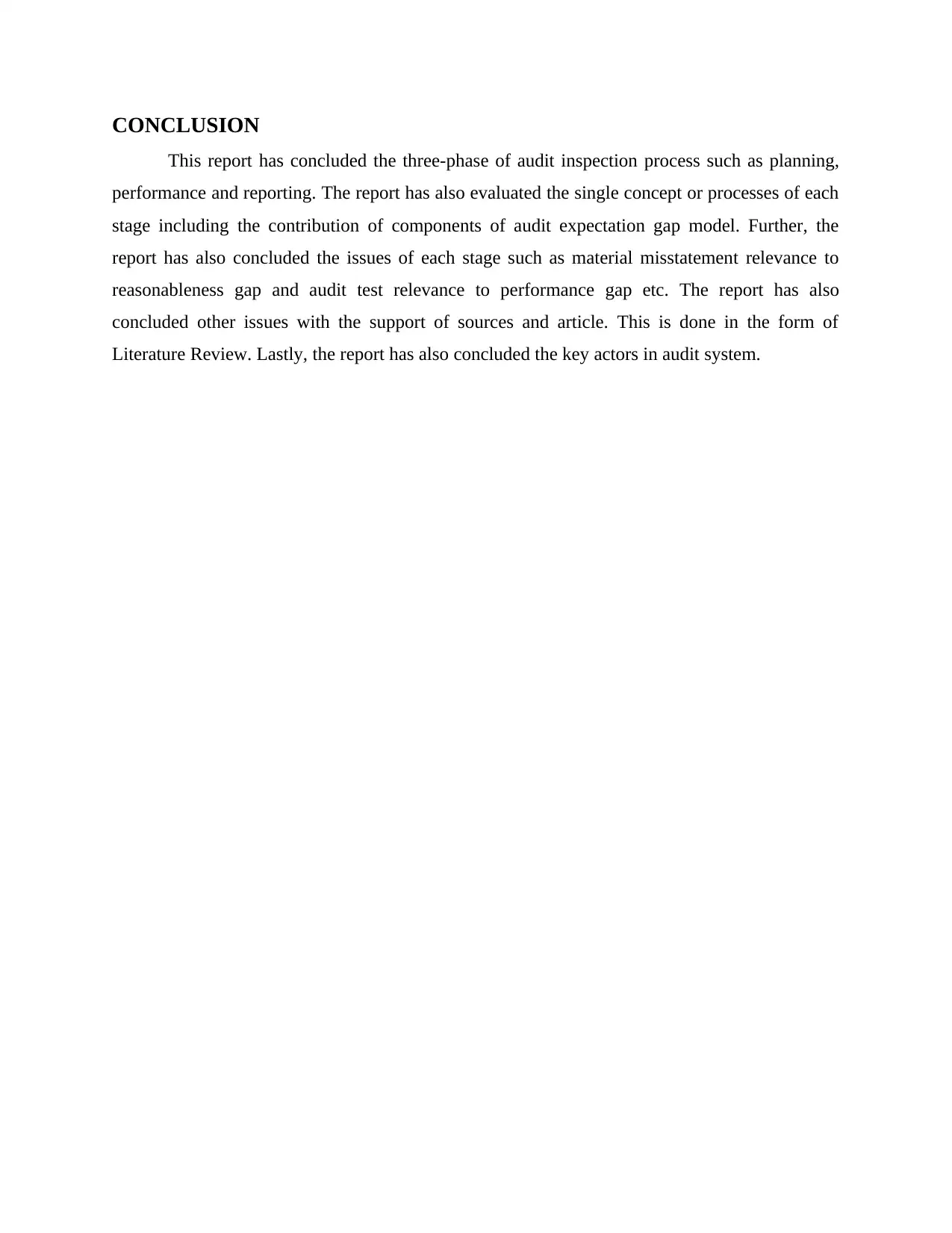
CONCLUSION
This report has concluded the three-phase of audit inspection process such as planning,
performance and reporting. The report has also evaluated the single concept or processes of each
stage including the contribution of components of audit expectation gap model. Further, the
report has also concluded the issues of each stage such as material misstatement relevance to
reasonableness gap and audit test relevance to performance gap etc. The report has also
concluded other issues with the support of sources and article. This is done in the form of
Literature Review. Lastly, the report has also concluded the key actors in audit system.
This report has concluded the three-phase of audit inspection process such as planning,
performance and reporting. The report has also evaluated the single concept or processes of each
stage including the contribution of components of audit expectation gap model. Further, the
report has also concluded the issues of each stage such as material misstatement relevance to
reasonableness gap and audit test relevance to performance gap etc. The report has also
concluded other issues with the support of sources and article. This is done in the form of
Literature Review. Lastly, the report has also concluded the key actors in audit system.
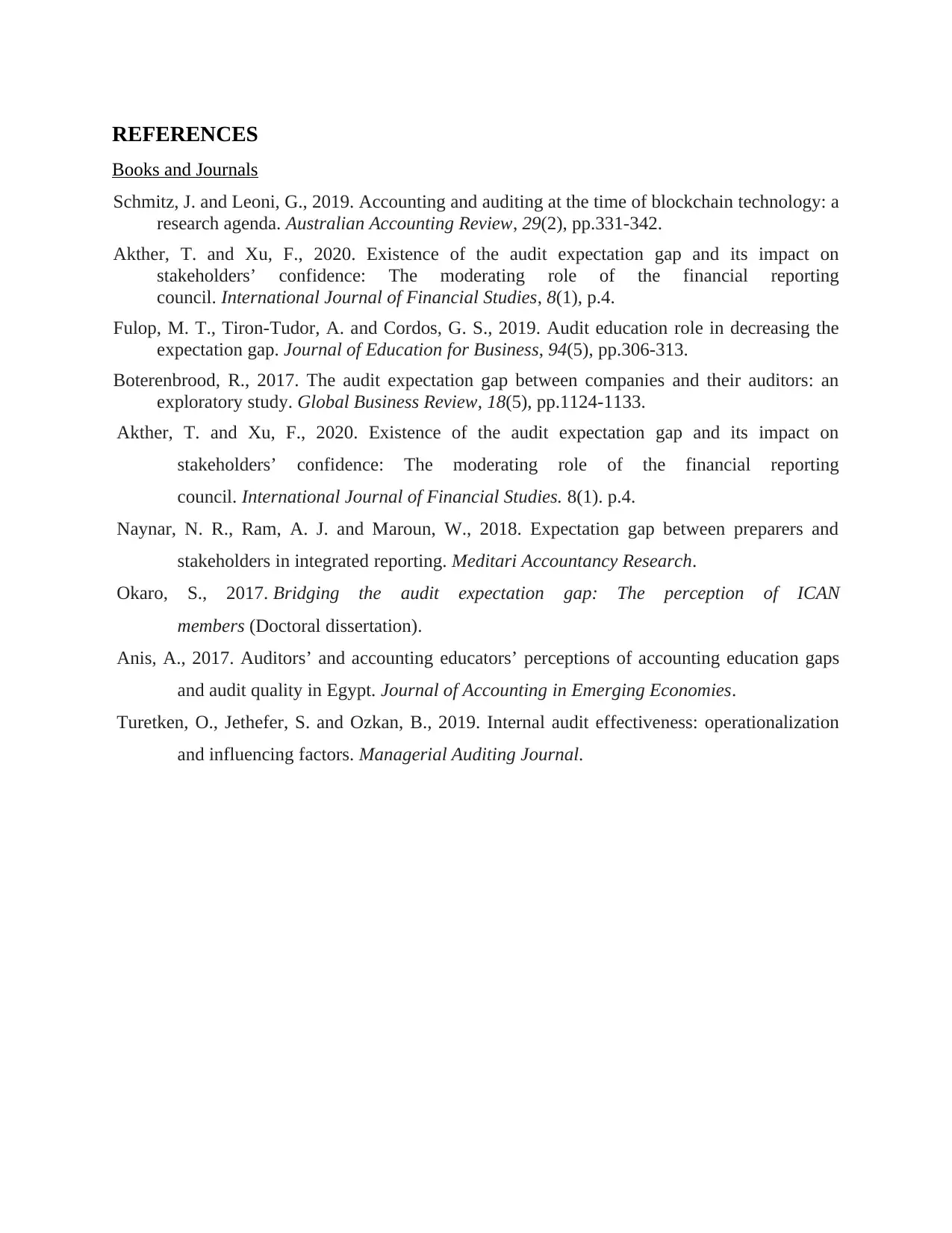
REFERENCES
Books and Journals
Schmitz, J. and Leoni, G., 2019. Accounting and auditing at the time of blockchain technology: a
research agenda. Australian Accounting Review, 29(2), pp.331-342.
Akther, T. and Xu, F., 2020. Existence of the audit expectation gap and its impact on
stakeholders’ confidence: The moderating role of the financial reporting
council. International Journal of Financial Studies, 8(1), p.4.
Fulop, M. T., Tiron-Tudor, A. and Cordos, G. S., 2019. Audit education role in decreasing the
expectation gap. Journal of Education for Business, 94(5), pp.306-313.
Boterenbrood, R., 2017. The audit expectation gap between companies and their auditors: an
exploratory study. Global Business Review, 18(5), pp.1124-1133.
Akther, T. and Xu, F., 2020. Existence of the audit expectation gap and its impact on
stakeholders’ confidence: The moderating role of the financial reporting
council. International Journal of Financial Studies. 8(1). p.4.
Naynar, N. R., Ram, A. J. and Maroun, W., 2018. Expectation gap between preparers and
stakeholders in integrated reporting. Meditari Accountancy Research.
Okaro, S., 2017. Bridging the audit expectation gap: The perception of ICAN
members (Doctoral dissertation).
Anis, A., 2017. Auditors’ and accounting educators’ perceptions of accounting education gaps
and audit quality in Egypt. Journal of Accounting in Emerging Economies.
Turetken, O., Jethefer, S. and Ozkan, B., 2019. Internal audit effectiveness: operationalization
and influencing factors. Managerial Auditing Journal.
Books and Journals
Schmitz, J. and Leoni, G., 2019. Accounting and auditing at the time of blockchain technology: a
research agenda. Australian Accounting Review, 29(2), pp.331-342.
Akther, T. and Xu, F., 2020. Existence of the audit expectation gap and its impact on
stakeholders’ confidence: The moderating role of the financial reporting
council. International Journal of Financial Studies, 8(1), p.4.
Fulop, M. T., Tiron-Tudor, A. and Cordos, G. S., 2019. Audit education role in decreasing the
expectation gap. Journal of Education for Business, 94(5), pp.306-313.
Boterenbrood, R., 2017. The audit expectation gap between companies and their auditors: an
exploratory study. Global Business Review, 18(5), pp.1124-1133.
Akther, T. and Xu, F., 2020. Existence of the audit expectation gap and its impact on
stakeholders’ confidence: The moderating role of the financial reporting
council. International Journal of Financial Studies. 8(1). p.4.
Naynar, N. R., Ram, A. J. and Maroun, W., 2018. Expectation gap between preparers and
stakeholders in integrated reporting. Meditari Accountancy Research.
Okaro, S., 2017. Bridging the audit expectation gap: The perception of ICAN
members (Doctoral dissertation).
Anis, A., 2017. Auditors’ and accounting educators’ perceptions of accounting education gaps
and audit quality in Egypt. Journal of Accounting in Emerging Economies.
Turetken, O., Jethefer, S. and Ozkan, B., 2019. Internal audit effectiveness: operationalization
and influencing factors. Managerial Auditing Journal.
⊘ This is a preview!⊘
Do you want full access?
Subscribe today to unlock all pages.

Trusted by 1+ million students worldwide
1 out of 9
Related Documents
Your All-in-One AI-Powered Toolkit for Academic Success.
+13062052269
info@desklib.com
Available 24*7 on WhatsApp / Email
![[object Object]](/_next/static/media/star-bottom.7253800d.svg)
Unlock your academic potential
© 2024 | Zucol Services PVT LTD | All rights reserved.




